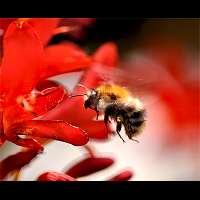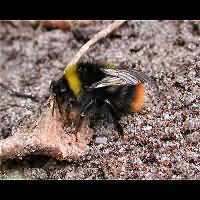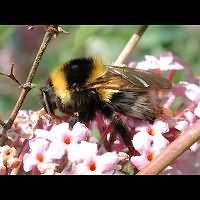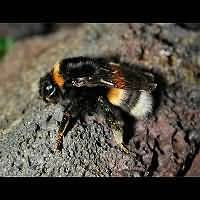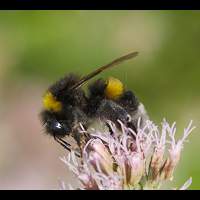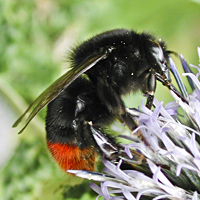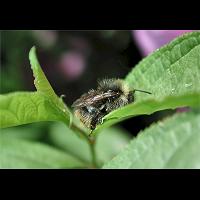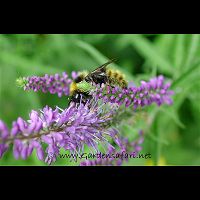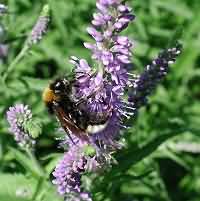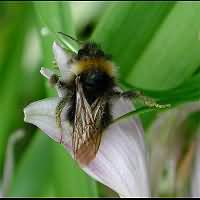[All pictures of garden wildlife on this page are thumbnails. Click on any thumbnail for a large format to be displayed.]
Bumblebees (Bombus sp.)
Bumblebees are large and extremely hairy bees which are relatively closely related to the well-known Honeybee. Most species live in colonies. Contrary to Honeybees, Bumblebees do not store food (honey) to survive winter. The little food they do store serves as a reserve meant for feeding the larvae and the egg-producing queen or it is used to survive cold, windy and rainy days. Just like in social wasps the whole colony dies at the end of the season, usually in late summer or autumn. The new queens seek for a place to hibernate. A Bumblebee colony is normally much smaller than the colonies of Honeybees or Wasps, which may comprise as many as several thousand individuals. Most Bumblebee colonies count about 50 to 150 animals. Only the Earth Bumblebee may have richly populated nests in which you find 200 up to 600 individuals.
A few species of Bumblebees are being bred with human intervention nowadays and they are being used for pollination of plants in greenhouses. They turn out to be very useful for tomatoe and cucumber plantations. You can buy such colonies in specialized shops and on the internet. When flying most bumblebees are producing lots of noise, attracting in this way our attention. They belong to the most beloved of all insects because they are the perfect messengers announcing that spring is on the way. Sometimes as soon as the end of February the first Bumblebee queens can already be seen flying from spring flower to spring flower. But usually they wait till the middle of March to come out of their hiding.
Bumblebees have typical warning colours: black and yellow or black and red. There is a very good reason for it: all species are capable of stinging although they are rather reluctant to do it. You can even put many species in your hand without too much risk of getting stung provided that you are very careful and not squeeze them. Beware of Bumblebees laying on their back! This is their typical defense position indicating they feel threatened and they are ready to sting! Even though the stinger of the bumblebees is build the same way as the Honeybee's, after stinging it will not remain in your skin. As a result a Bumblebee may sting you more than once. The poison it injects is harmless, except for those allergic to wasp poison. The level of pain you feel after stinging varies from species to species.
Nowadays all bumblebees are put into one single genus: Bombus. Sometimes a second genus is used (Psithyrus), comprised of all Cuckoo Bumblebees. In older days Bumblebees were put in numerous genera. The length of the tongue was used as a decisive feature for determination. Gardensafari will give you the previous name of each species as well.
Bumblebees are typical insects of moderate climate zones with a few species capable of surviving even arctic conditions. You won't find them in the tropics though. The hairs on the body ensure they don't cool off fast. But there is more. Just like mammals Bumblebees control their body temperature. They can detach the muscles normally used to move their wings and by moving these muscles rapidly they produce their own body heat. This is the reason you can sometimes find a motionless bumblebee on the ground or a flower. It is not dying or sick, but simply busy warming up its own body. Due to the fact that the wings are detached from their muscles such Bumblebee is temporarily not capable of flying. Bumblebees maintain their body temperature between 34 and 38 Centigrade. Only in winter, when temperatures drop below freezing point, they can't keep up the high temperature anymore and go into hibernation. This is the reason why many species don't care about cold or rainy weather conditions. Bumblebees can be active on cold sunny days, while the temperature is still one or two degrees below the freezing point. Honeybees for instance will become active only when temperatures raise above some 15 degrees Centigrade!
A few species of Bumblebees are being bred with human intervention nowadays and they are being used for pollination of plants in greenhouses. They turn out to be very useful for tomatoe and cucumber plantations. You can buy such colonies in specialized shops and on the internet. When flying most bumblebees are producing lots of noise, attracting in this way our attention. They belong to the most beloved of all insects because they are the perfect messengers announcing that spring is on the way. Sometimes as soon as the end of February the first Bumblebee queens can already be seen flying from spring flower to spring flower. But usually they wait till the middle of March to come out of their hiding.
Bumblebees have typical warning colours: black and yellow or black and red. There is a very good reason for it: all species are capable of stinging although they are rather reluctant to do it. You can even put many species in your hand without too much risk of getting stung provided that you are very careful and not squeeze them. Beware of Bumblebees laying on their back! This is their typical defense position indicating they feel threatened and they are ready to sting! Even though the stinger of the bumblebees is build the same way as the Honeybee's, after stinging it will not remain in your skin. As a result a Bumblebee may sting you more than once. The poison it injects is harmless, except for those allergic to wasp poison. The level of pain you feel after stinging varies from species to species.
Nowadays all bumblebees are put into one single genus: Bombus. Sometimes a second genus is used (Psithyrus), comprised of all Cuckoo Bumblebees. In older days Bumblebees were put in numerous genera. The length of the tongue was used as a decisive feature for determination. Gardensafari will give you the previous name of each species as well.
Bumblebees are typical insects of moderate climate zones with a few species capable of surviving even arctic conditions. You won't find them in the tropics though. The hairs on the body ensure they don't cool off fast. But there is more. Just like mammals Bumblebees control their body temperature. They can detach the muscles normally used to move their wings and by moving these muscles rapidly they produce their own body heat. This is the reason you can sometimes find a motionless bumblebee on the ground or a flower. It is not dying or sick, but simply busy warming up its own body. Due to the fact that the wings are detached from their muscles such Bumblebee is temporarily not capable of flying. Bumblebees maintain their body temperature between 34 and 38 Centigrade. Only in winter, when temperatures drop below freezing point, they can't keep up the high temperature anymore and go into hibernation. This is the reason why many species don't care about cold or rainy weather conditions. Bumblebees can be active on cold sunny days, while the temperature is still one or two degrees below the freezing point. Honeybees for instance will become active only when temperatures raise above some 15 degrees Centigrade!
Common Carder Bee (Bombus pascuorum)
The Common Carder Bee is the most common bumblebee and a frequent visitor of gardens and parks. More...
The Common Carder Bee is the most common bumblebee and a frequent visitor of gardens and parks. More...
Garden Bumblebee (Bombus hortorum)
The Garden Bumblebee may reach a wingspan of 4 cm making it the biggest species in most gardens. More...
The Garden Bumblebee may reach a wingspan of 4 cm making it the biggest species in most gardens. More...
Earth Bumblebee (Bombus terrestris)
The Earth Bumblebee is often referred to as the Buff-tailed Bumblebee. More...
The Earth Bumblebee is often referred to as the Buff-tailed Bumblebee. More...
White-tailed Bumblebee (Bombus lucorum)
The White-tailed Bumblebee is a very common species thus often found in gardens. More...
The White-tailed Bumblebee is a very common species thus often found in gardens. More...
Red-tailed Bumblebee (Bombus lapidarius)
The Red-tailed Bumblebee is slightly more aggressive than most other bumblebees. More...
The Red-tailed Bumblebee is slightly more aggressive than most other bumblebees. More...
Red-shanked Carder Bee (Bombus ruderarius)
The Red-shanked Carder Bee is difficult to identify because of its variable appearance. It quickly looses hairs and colours. More...
The Red-shanked Carder Bee is difficult to identify because of its variable appearance. It quickly looses hairs and colours. More...
Large Yellow Bumblebee (Bombus distinguendus)
Is this the extremely rare Large Yellow Bumblebee, or isn't? Some think it is, others think it is certainly not. More...
Is this the extremely rare Large Yellow Bumblebee, or isn't? Some think it is, others think it is certainly not. More...
Vestal Cuckoo Bumblebee (Bombus vestalis)
The Vestal Cuckoo Bumblebee hires nannies to take care of her eggs and larvae. More...
The Vestal Cuckoo Bumblebee hires nannies to take care of her eggs and larvae. More...
Four-coloured Cuckoo Bumblebee (Bombus Sylvestris)
The Four-coloured Cuckoo Bumblebee is one of the most common Cuckoo Bumblebees in the UK. More...
The Four-coloured Cuckoo Bumblebee is one of the most common Cuckoo Bumblebees in the UK. More...

© Copyright 1998-2024 gardensafari.net (Hania Berdys)

 English / engels
English / engels  Dutch / nederlands
Dutch / nederlands